The expert’s guide to the perfect roast chicken (and the simple tip to make carving a breeze)
Step up your Sunday roast game with some smart techniques and some even smarter side dishes from Meatsmith butcher Troy Wheeler and chef Andrew McConnell.
There’s something irresistibly nostalgic and familiar about a Sunday roast.
For butcher Troy Wheeler, who has collaborated with chef Andrew McConnell, on both Melbourne butchery and specialty food business Meatsmith and a cookbook of the same name, a roast symbolises coming together for a family meal.
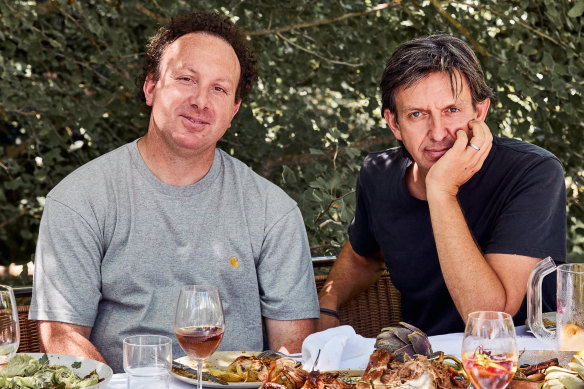
“I come from a large family of eight boys,” says Wheeler. “Sunday was the one day of the week we’d try to come together around the table.”
It’s a tradition he maintains with his own young family and friends, who gather on Sundays, sometimes for a roast, for a large, shared steak cooked on the barbie, or for a spread of seafood and salads.
Both authors contributed favourite recipes to Meatsmith: Home Cooking for Friends and Family, but the roast chicken was a joint effort, so to speak.
McConnell suggested the cooking temperature and timing, and Wheeler advised on how to remove the wishbone, a technique he says makes the bird easier to carve. “The first time people try it, they might find it tricky to identify the wishbone,” he says. “But it gets easier with practice.”
Meatsmith: Home Cooking for Friends and Family sold out on its first print run and is now in its second printing. Copies will be available by the end of February.
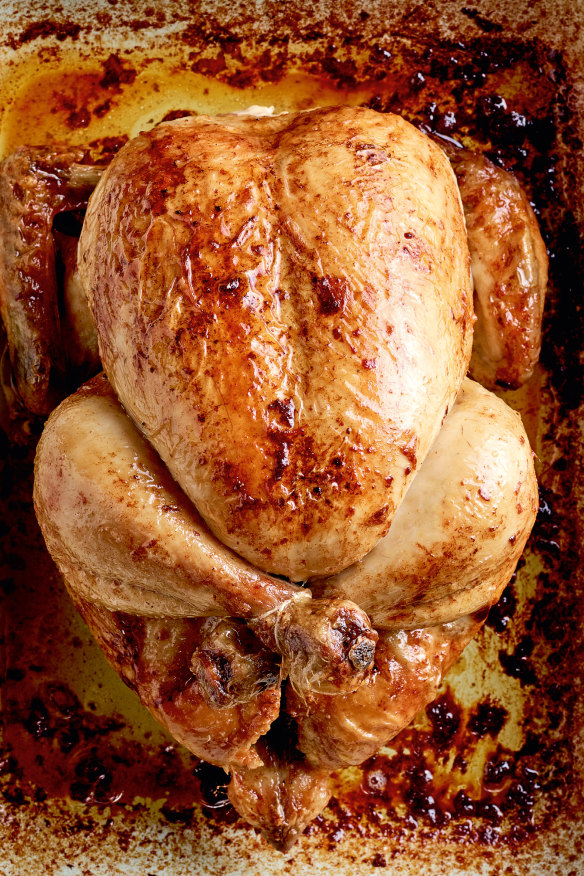
A perfect roast chicken
This is the recipe we use when roasting a chicken at home, and includes the all-important step of removing the wishbone before you roast the bird. It’s quite a simple manoeuvre and makes the chicken super easy to carve. Leave the chicken uncovered in the fridge overnight for the best crispy skin.
INGREDIENTS
Chicken
- 120g unsalted butter, at room temperature
- pinch of salt
- size 16 (1.6kg) chicken, at room temperature
- ½ lemon
- sea salt, to serve
Pan-juice gravy
- roasting juices from your cooked chicken
- 1 tbsp plain flour
- 20g unsalted butter
- 125ml (½ cup) water
- salt and pepper, to season
METHOD
- To cook the chicken: Place the butter in the bowl of a stand mixer fitted with the paddle attachment (or whisk by hand), season with salt and mix on medium speed until smooth and fluffy, for about 2-3 minutes. Add 1 tablespoon of the Georgian five-spice (see recipe below) to the butter, if using, and mix on medium speed until the spice is fully combined with the butter.
- To identify the wishbone, use your finger to feel around under the skin up through the top of the neck cavity at the front of the chicken breasts. When you feel the wishbone, use a small, pointed knife to cut around the outside of it. Once you have cut as much as you can, without piercing the skin, pull the wishbone out.
- Preheat the oven to 200C fan-forced (220C conventional). Place the chicken in a roasting tray. Rub the chicken all over with the whipped butter, being very liberal (though any leftover butter can go into the cavity). Put the lemon inside the cavity then truss the chicken legs by tying the drumsticks together with twine so they are tight against the body. Roast the chicken, breast side up, for 45 minutes, then turn off the oven and leave the chicken in the oven for 20 minutes or until the internal temperature in the thickest part of the leg is 64C when tested with a meat thermometer. Remove the chicken from the tray, reserving the roasting juices, and rest, covered, for 15 minutes.
- To make the pan-juice gravy: Transfer the roasting juices from the tray to a medium saucepan, scraping any caramelised bits from the bottom of the tray. Mix the flour and butter in a small bowl. Add the water to the pan juices and bring to a gentle simmer over a medium heat. Add the flour and butter mixture and whisk until the sauce thickens and there are no lumps, about 2-3 minutes. If the gravy begins to split, add a splash of water, remove from the heat and continue to whisk. Season to taste.
- To serve: To carve the chicken, remove the lemon from the cavity and cut down either side of the breasts; they will come away effortlessly. Remove the legs and cut in half through the joints (return to a hot oven for a few minutes if they are a touch pink). Arrange the chicken portions on a serving platter and squeeze the lemon half over to dress. Drizzle over the pan-juice gravy and sprinkle with sea salt.
Serves 4
Georgian five-spice (optional)
Troy Wheeler was introduced to this Eastern European spice mix by a friend in Los Angeles and says it lends an aromatic, curry-like note to the chicken.
INGREDIENTS
- 2 tsp fenugreek seeds
- 2 bay leaves
- 1 tbsp ground coriander
- 1 tbsp dried savory or thyme
- 1½ tsp dried dill
- ½ tsp black pepper
- ½ tsp salt
METHOD
Combine the ingredients in a spice grinder, mill or mortar and grind to a fine powder. Store in an airtight container or jar for up to 6 months.
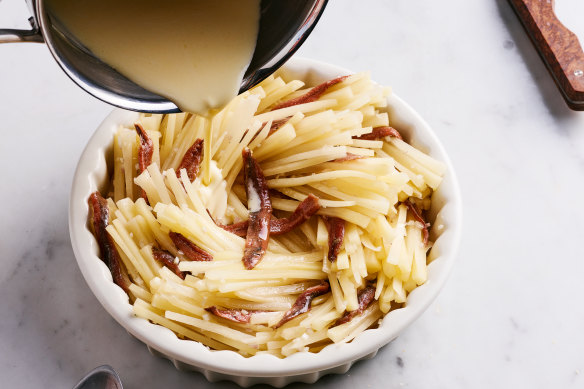
Jansson’s temptation
This Swedish Christmas favourite was named (according to some) after a food-loving Swedish opera singer called Pelle Janzon, who was singing his heart out in the early 1900s. Andrew first learned to cook this dish from the late Walter Bourke, a former ballet dancer and influential Melbourne chef, whose wife Maria was Swedish. It’s layered with anchovies, smothered in cream and baked, so you can’t go wrong. Don’t wait for Christmas.
INGREDIENTS
- 1 tbsp softened butter
- 6 medium Desiree potatoes, rinsed and cut into large matchsticks (I use a mandoline)
- 80g anchovy fillets
- 5 large golden eschalots, diced
- 500ml (2 cups) pouring cream
- ½ tsp salt flakes
- pinch of white pepper
- extra 50g cold unsalted butter, diced
METHOD
- Preheat the oven to 170C fan-forced (190C conventional). If you are using a fan-forced oven, turn off the fan. We find conventional heat is better for this recipe.
- Butter the base of a 20 × 26cm ceramic baking dish (or a round, ovenproof dish of a similar size) with the soft butter. Layer 1cm of the potatoes in the base of the dish. Evenly arrange one-third of the anchovies and one-third of the eschalots over the potato. Repeat twice more with remaining anchovies, eschalots and potato, finishing with a layer of potato.
- Combine cream, salt and pepper in a small saucepan over medium heat and bring to a simmer. Immediately pour over the potatoes. Top with the diced butter. Bake for 1 hour or until the potatoes are soft when pierced with a knife (if they seem a little firm, cook for a further 10 minutes or until cooked). Set aside for 30 minutes to rest or until ready to serve. Return to the oven for 15 minutes to reheat when you wish to serve.
Serves 8
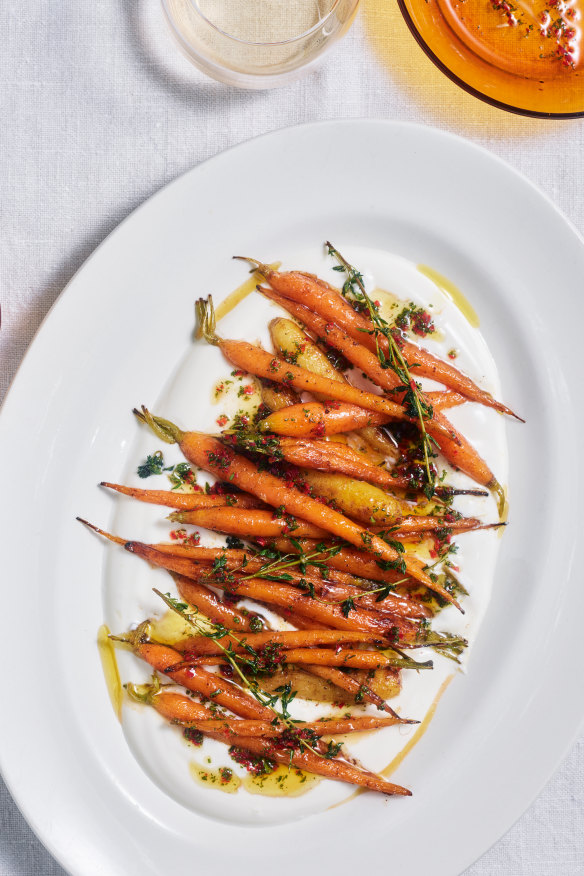
Carrots with smoked yoghurt
To peel or not to peel, this is the question that has still not been resolved in our kitchen. For this preparation, however, we like to use the finest Dutch carrots we can find, where the skin is thin and brings so much flavour to the dish. If using larger conventional carrots or heirloom carrots, do peel them as the skin can be bitter, and it prevents any outside flavours from penetrating the flesh.
INGREDIENTS
- 200g plain yoghurt
- handful of wood chips, for smoking
- 1 tbsp honey
- 3 tbsp extra virgin olive oil
- 1 long red chilli, seeded and finely chopped
- 1 tbsp oregano leaves
- zest and juice of 1 lemon
- 1 tbsp unsalted butter, melted
- 2 bunches Dutch carrots
- 5 thyme sprigs
- salt and freshly ground black pepper, to season
METHOD
- To make the smoked yoghurt and dressing: Spread the yoghurt out on a small tray and keep it cold in the fridge. Tear off a sheet of aluminium foil about the size of an A4 sheet of paper. Fold it in half twice into a smaller square and turn up the sides so it resembles a small tray. Pinch the corners so it stays together.
- Place the aluminium tray at one end of a large roasting tray and fill it with wood chips. Tear off 2 more larger sheets of aluminium foil big enough to cover your roasting tray. Remove the small tray of yoghurt from the fridge and keep it close to your larger tray.
- Using a blowtorch, light the wood chips. Once they are lit, blow out the flames and quickly place the small tray with the yoghurt at the opposite end to the smouldering wood chips. Cover the whole roasting tray with the larger pieces of aluminium foil you prepared, making sure it is tight and trapping in all the smoke.
- Leave it covered for about 20 minutes. Uncover and remove the smaller tray of yoghurt. Give it a mix with a spoon and transfer it to an airtight container. It will keep refrigerated for up to 1 week.
- To make the dressing, whisk the honey, 2 tablespoons of the olive oil and a pinch of salt together in a medium-sized bowl. Add the chilli, oregano, lemon zest and juice. Set aside until ready to serve.
- To cook the carrots and assemble the salad: Bring a large saucepan of salted water to the boil. Cook the carrots until tender; depending on the size it will take anything from 3-10 minutes (use a small paring knife to check whether the carrots are tender; there needs to be a slight resistance). Once ready, remove the carrots from the water and drain.
- Heat a large, heavy-based frying pan over medium heat and add the carrots. If they don’t all fit in the pan, cook the carrots in two batches. Add the butter and the remaining tablespoon of olive oil, followed by the carrots and saute, shuffling around in the pan until golden, caramelised and tender, about 3-6 minutes. Add the thyme sprigs for the last minute of cooking and toss the carrots and thyme together in the pan. Season to taste.
- Place the carrots in a bowl with the dressing. Taste and season with a pinch of salt and leave the carrots to marinate at room temperature for half an hour or so. To serve, arrange the smoked yoghurt on a serving platter and top with the marinated carrots.
Serves 6
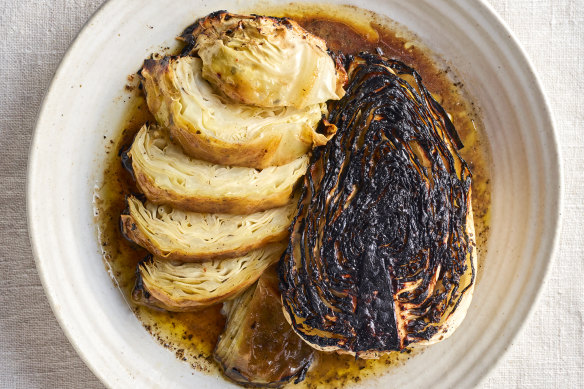
Charred sugarloaf cabbage with kombu butter
The pointed sugarloaf cabbage, also known as hispi, is excellent for this dish: it’s structurally resilient under high heat and its compressed leaves are perfect for soaking up all the butter and kombu flavours, which lend a rich umami element to the sweet, charred cabbage. Finishing it with buttery lardo adds another layer of richness. If you can’t find sugarloaf cabbage, use half of a very firm savoy cabbage.
INGREDIENTS
- 2 × 2.5cm pieces dried kombu (see note)
- 120ml grapeseed oil
- 1 large sugarloaf cabbage, outer leaves removed, halved
- 150g unsalted butter
- 300ml chicken stock
- 1 tbsp apple cider vinegar
- salt, to season
- 8 slices lardo (optional)
METHOD
- Preheat oven to 160C fan-forced (180C conventional).
- Using tongs, hold the kombu over an open flame for about 2 minutes, turning often, until lightly toasted. Set aside to cool. Transfer to a spice mill or use a mortar and pestle to grind into a fine powder.
- Heat the oil in an ovenproof frypan over a medium-high heat. Cook the cabbage, cut-side down, undisturbed for 10-15 minutes, until the underside is blackened (the edge of the sides will start to brown as well).
- Reduce heat to medium-low, add all but two knobs of the butter to the frypan and shake the pan to help the butter get around and under the cabbage. As soon as the butter is melted and foaming, tilt the frypan towards you and spoon the browning butter over the cabbage, being sure to bathe the area around the thickest part. Add the chicken stock and vinegar and place the frypan in the oven for 20 minutes – or until the cabbage is tender. Remove from the oven, add the remaining butter and the toasted kombu powder, return to medium heat on the stovetop and baste with the butter and kombu for a further 5 minutes.
- Transfer the cabbage to a cutting board and cut into 2 halves. Reserve the cooking juices in the pan. Pull leaves open slightly and season with salt.
- Arrange the lardo over the warm cabbage and leave to sit for 1-2 minutes for the lardo to soften. Transfer to a serving plate and dress with the reserved juices from the pan.
Serves 4
Note: Dried, edible kelp that is cultivated in Korea and Japan, kombu is usually sold in large sheets.
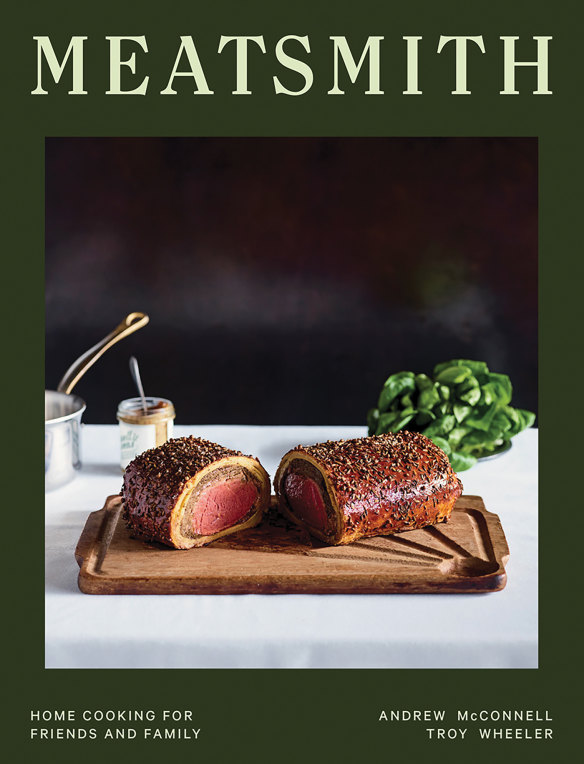
This is an edited extract from Meatsmith: Home Cooking for Friends and Family by Andrew McConnell and Troy Wheeler, photography by Mark Roper. Published by Hardie Grant Books, RRP $60. Buy now.
Appears in these collections
The best recipes from Australia's leading chefs straight to your inbox.
Sign up